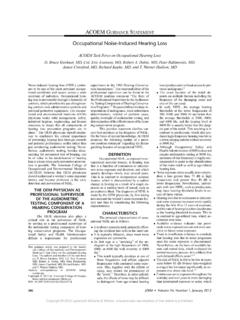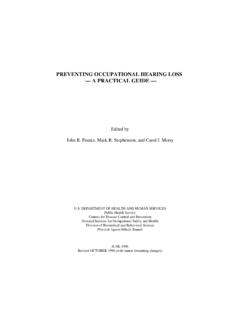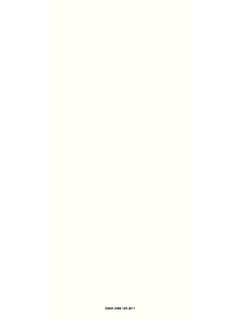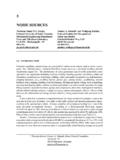Transcription of Health Surveillance for Noise Induced Hearing Loss
1 Health and Safety ExecutiveHealth Surveillance forNoise Induced Hearing LossHealth Effects of Noise Exposure Noise Induced Hearing loss permanent, irreversible Tinnitus May also affect performance, communication & audibility of safety/warning signalsNoise Induced Hearing loss Hearing loss caused by work is a significant occupational disease Recent research indicates 170,000 people suffer from Hearing damage due to Noise at work Factors contributing to damage include the intensity of Noise and length of exposureHealth Surveillance Specific regulation (reg 9) for Health Surveillance HSE guidance specifies risk at 85dB Employers need to provide Health Surveillance for all workers regularly exposed above 85dBWhat is Health Surveillance for NIHL? Health Surveillance is audiometry This is a method of Hearing checks which measures the sensitivity of Hearing over a range of sound frequencies This is done by presentation of pure tones to each ear at specific frequenciesIssues for new guidance for Health Surveillance When will it be required all those regularly exposed above 85dB Only for susceptible individuals if requested between 80 and 85dB Who should conduct the testing Any person with appropriate training referral to a doctor when problem identified referral facilitated by categorisation schemeThe Health Surveillance provider what to expect Shouldbe designated person in charge of HS programme occupational physician, or nurse with specialist training in audiometry, or audiologist.
2 Person conducting test as a minimum, appropriate training so that testing is carried out in a repeatable and accurate manner. training syllabus by the British Society of Audiology HSE likely to develop syllabus independentlyChanges to current guidance Reflects changes in legislation Improvement to current categorisation scheme simpler & easier to use/interpret Included as a chapter within main guidance so that everybody has access to the informationHSE Categorisation SchemeCategoryAction1. ACCEPTABLE Hearing ABILITYH earing within normal Hearing IMPAIRMENTMay indicate developing NIHLW arning3. POOR HEARINGS uggests significant NIHLR eferral4. RAPID Hearing LOSSR eduction in Hearing level of 30 dB or more, within 3 years or less. ReferralFrequency of Health Surveillance Baseline assessment Annual for 2 years 3 yearly thereafter, unless cause for concernOther Health Issues for RA Within RA reg (5) requirement to consider interactions between Noise and ototoxic subs and Noise and vibration Likely to be guidance on ototoxic subs of concern on website Otherwise employers just need to note these mixed exposures and monitor effects through HS
















